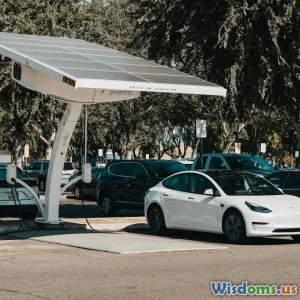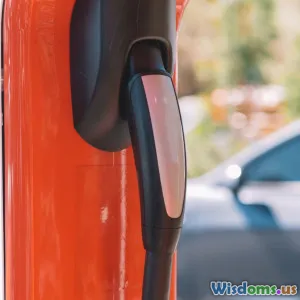
Why Rural Electric Vehicle Adoption Is Lagging Behind
10 min read Exploring the critical factors causing slower electric vehicle adoption in rural America and potential solutions to bridge the gap. (0 Reviews)
Why Rural Electric Vehicle Adoption Is Lagging Behind
As electric vehicles (EVs) zoom past gas guzzlers in city centers and suburban streets, their presence on rural roads remains sparse. Despite growing environmental concerns and the rapid technological advancement of EVs, adoption rates in rural areas trail significantly behind. This discrepancy raises an essential question: Why is electric vehicle adoption lagging in rural communities?
This article embarks on a deep dive into the distinctive challenges rural regions face concerning EV integration. From sparse charging infrastructure to sociocultural factors, these obstacles hinder uptake but are not insurmountable. Understanding these barriers is the first step toward an inclusive electric future.
The Current Landscape of Rural EV Adoption
Electric vehicle sales have skyrocketed globally, but data from sources such as the U.S. Department of Energy (DOE) reveal stark disparities depending on geography. While urban EV registrations have increased exponentially, rural areas see less than half the adoption rate.
A 2023 DOE report showed that less than 3% of vehicles in rural counties are electric compared to over 10% in metropolitan areas. Many rural states rely heavily on internal combustion engine vehicles due to the extensive travel distances and limited alternatives. Since transportation accounts for about 29% of greenhouse gas emissions in the U.S., failing to embrace EVs in rural communities slows national progress on emissions reduction.
Infrastructure Challenges: The Charging Conundrum
One of the most glaring barriers is the insufficient EV charging infrastructure outside cities.
Lack of Public Charging Stations
In urban and suburban zones, EV owners have relatively easy access to fast chargers at malls, workplaces, and public garages. However, rural drivers typically encounter long distances between towns and service destinations. According to the National Renewable Energy Laboratory, rural counties average just 1.5 publicly accessible fast chargers per 100 square miles, compared to over 10 in urban counties.
Home Charging Barriers
Home charging seems a straightforward solution, but rural areas often have unique limitations:
- Older Housing Stock: Many rural homes have outdated electrical systems unable to safely support Level 2 chargers without costly upgrades.
- Limited Electrical Grid Capacity: Remote locations can have less robust grids, sometimes reliant on off-grid or subsidized power sources, complicating high-load charging.
Range Anxiety Amplified
Range anxiety—the fear of running out of power—affects all EV users but is especially acute in places with scarce charging options. Rural residents often drive longer distances regularly for work, agriculture, education, or healthcare, magnifying this concern.
For example, a farmer in Montana might need to travel 50+ miles one-way for supplies—a trip that pushes the limits of standard EV ranges without reliable recharging points.
Economic Factors and Vehicle Affordability
Higher Upfront Costs
EVs generally have higher upfront purchase prices than equivalent gasoline vehicles, even factoring in available incentives. In rural areas, where average household incomes are often lower, the sticker shock can be a significant barrier.
An analysis by the Rural Policy Research Institute found median rural household incomes fall roughly 20% below national urban averages, highlighting affordability challenges.
Limited Incentive Awareness and Access
Many EV incentives, from federal to state programs, require dealership networks, paperwork, or locations more accessible in urban settings. Rural consumers may lack awareness or find it difficult to navigate cumbersome rebate processes.
Economic Reliance on Combustion Vehicles
In some rural economies, trucks and diesel vehicles are essential for occupational tasks like farming, mining, or logging. Electric pickups and heavy-duty EVs remain emerging or have limited functionality and availability, delaying broader EV adoption.
Sociocultural and Behavioral Influences
Tradition and Automotive Culture
Automobiles in rural contexts are more than transportation; they symbolize independence, ruggedness, and reliability. Longstanding preferences for brands synonymous with toughness (e.g., Ford F-Series, Chevrolet Silverado) can bias purchasing towards traditional gas models.
Skepticism of New Technology
A Pew Research Center study indicated that rural populations often exhibit more skepticism toward new technologies, including EVs, due in part to limited familiarity and perceived complexity.
Lack of Exposure and Social Proof
EV adoption often spreads via social proof—the more people see electric vehicles in their community, the more likely they are to consider buying one. When rural areas have few EVs on the road, this social signal is weak.
Environmental and Policy Dimensions
Rural areas typically contribute significantly to carbon footprints due to transportation demands but receive less targeted policy support to decarbonize vehicles.
Sparse Government Support
Many rural counties lag behind in funding local EV infrastructure projects or regulations encouraging EV use. Without active municipal programs or local champions, momentum is slow.
Disconnect from Climate Initiatives
Environmental campaigns and incentives often concentrate on urban pollution issues, unintentionally sidelining rural concerns where the impact of vehicle emissions is less visible though still significant.
Bridging the Gap: Strategies to Accelerate Rural EV Adoption
Despite the challenges, there are promising initiatives and approaches to level the playing field.
Expanding Charging Networks Strategically
- Mobile Chargers and Pop-Up Stations: Some programs deploy mobile fast chargers for events or hotspots.
- Collaborations with Local Businesses: Gas stations, rural grocery stores, and community centers can host level 2 or DC fast chargers.
- Incentivizing Grid Upgrades: Governments can fund modernizing rural electrical infrastructure to support home charging.
Promoting Affordable EV Options
The arrival of lower-cost models like the Chevrolet Bolt or new affordable EV pickups could change cost dynamics for rural buyers.
States can tailor incentive programs to prioritize rural households and streamline rebate access with local dealers.
Educational Campaigns
Local EV demonstration days, driver testimonials, and collaboration with rural extension programs can increase awareness and counter skepticism.
Enhancing Vehicle Utility
Encouraging manufacturers to accelerate development of EV trucks and SUVs designed for heavy-duty, long-range rural usage addresses vital occupational needs.
Policy Innovation
Federal and state governments can prioritize rural-inclusive transportation policies, such as earmarking funds specifically for rural EV infrastructure and outreach.
Real-World Examples: Success Stories
-
Vermont’s Rural EV Initiatives: Vermont offers grants to rural municipalities for charging station installation and partners with agricultural extension agents to promote EV benefits among farmers.
-
Montana’s Electrification Program: Montana’s Transportation Department collaborates with utilities to upgrade grid capacity and provides educational resources about electric pickups.
-
Ohio’s Rural Ride and Charge Program: This initiative funds fast charger deployment along rural corridors, increasing travel feasibility and confidence.
Conclusion: Driving Toward Inclusive Electrification
The slower pace of EV adoption in rural areas is a multifaceted issue rooted in infrastructure deficits, economic realities, cultural attitudes, and policy gaps. However, this lag need not persist.
Closing this rural-urban EV divide is critical—not only for equity but also for achieving broader climate objectives and energy independence.
By investing in charging infrastructure, fostering affordable options, supporting education, and tailoring policies to rural contexts, we can accelerate rural EV adoption. Those long stretches of country roads filled with electric vehicles represent a cleaner, more sustainable future accessible to all.
Every rural driver deserves the opportunity to plug in, charge up, and join the electric revolution.
References:
- U.S. Department of Energy, Alternative Fuels Data Center (2023)
- National Renewable Energy Laboratory, EV Infrastructure Reports (2022)
- Rural Policy Research Institute, Income and Economic Analysis (2023)
- Pew Research Center, Technology Adoption Trends (2021)
- Vermont Agency of Transportation EV Grants
- Montana Department of Transportation EV Programs
- Ohio Public Utilities Commission EV Initiatives
By addressing these layered challenges thoughtfully, rural America can accelerate EV adoption and contribute meaningfully to a sustainable transportation future.
Rate the Post
User Reviews
Popular Posts




















